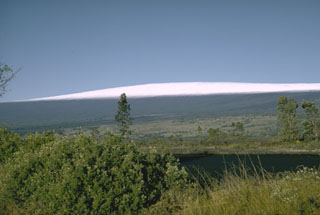Report on Mauna Loa (United States) — 7 December-13 December 2022
Smithsonian Institution / US Geological Survey
Weekly Volcanic Activity Report, 7 December-13 December 2022
Managing Editor: Sally Sennert.
Please cite this report as:
Global Volcanism Program, 2022. Report on Mauna Loa (United States) (Sennert, S, ed.). Weekly Volcanic Activity Report, 7 December-13 December 2022. Smithsonian Institution and US Geological Survey.
Mauna Loa
United States
19.475°N, 155.608°W; summit elev. 4170 m
All times are local (unless otherwise noted)
HVO reported that activity at Mauna Loa’s Fissure 3 declined during 7-9 December and then ceased on 10 December. The main lava flow had only advanced a small distance during 6-7 December, at a rate of about 6 m per hour, possibly due to a significant breakout that had occurred about 4.5 km upslope of the flow front. Lava erupting from Fissure 3 was greatly reduced by the morning of 8 December. Lava overtopped channels near the vent but had not advanced farther than 4.4 km from the vent by 0930. The channel at lower elevations appeared to be drained and was likely no longer feeding the main flow which had stalled about 2.8 km from the Daniel K. Inouye Highway (Saddle Road). The sulfur dioxide emission rate had declined to 30,000 tonnes per day. By 1130 on 9 December low lava fountains at Fissure 3 fed flows that traveled as far as 2.65 km NE. By 0700 on 10 December a lava pond in the Fissure 3 vent was visible and fed short lava flows that stagnated at 2.6 km. Tremor levels were slowly declining and the sulfur dioxide emission rate was about 2,000 tonnnes per day. Lava was confined to the small pond by 1435 and gas emissions had significantly declined. HVO lowered the Volcano Alert Level to Watch (the second highest level on a four-level scale); the Aviation Color Code remained at Orange (the second highest level on a four-color scale).
No activity was visible on the flow field overnight during 10-11 December, and by 0700 on 11 December the Fissure 3 vent was barely incandescent. Scientists observed no lava movement and only minor incandescence at the vent during an overflight in the early morning of 12 December. They heard a small explosion that accompanied a spray of spatter from the W end of the fissure. On 13 December HVO lowered the Volcano Alert Level to Watch and the Aviation Color Code to Yellow and noted that lava effusion at Fissure 3 had ceased on 10 December, sulfur dioxide emissions had decreased to near pre-eruption background levels, and volcanic tremor and earthquakes associated with the eruption were greatly diminished.
Geological Summary. Massive Mauna Loa is a basaltic shield volcano that rises almost 9 km from the ocean floor to form the world's largest Holocene volcano. Flank eruptions typically occur from the lengthy NE and SW rift zones, and from the Moku'aweoweo summit is caldera, which is within an older and larger 6 x 8 km caldera. Two of the youngest large debris avalanches documented in Hawaii traveled nearly 100 km from Mauna Loa; the second of the Alika avalanches was emplaced about 105,000 years ago (Moore et al., 1989). Almost 90% of the surface of the volcano is covered by lavas less than 4,000 years old (Lockwood and Lipman, 1987). Beginning about 1,500 years ago, a series of voluminous overflows from a summit lava lake covered about 25% of the volcano's surface. Over the last 750 years, from shortly after the formation of Moku'aweoweo caldera until the present, an additional 25% of the volcano has been covered with lava flows, mainly from summit and NW rift zone vents.
Source: US Geological Survey Hawaiian Volcano Observatory (HVO)

